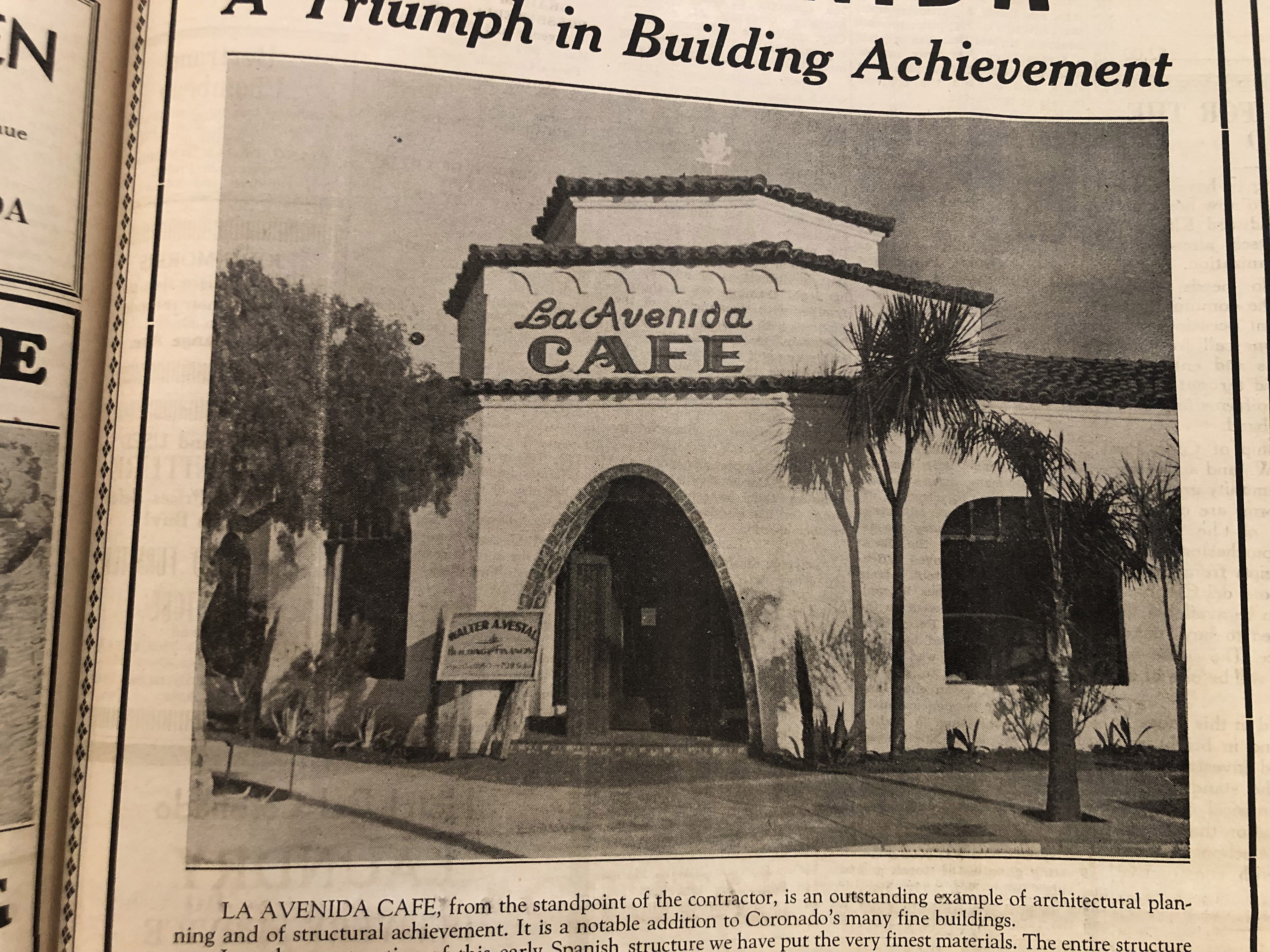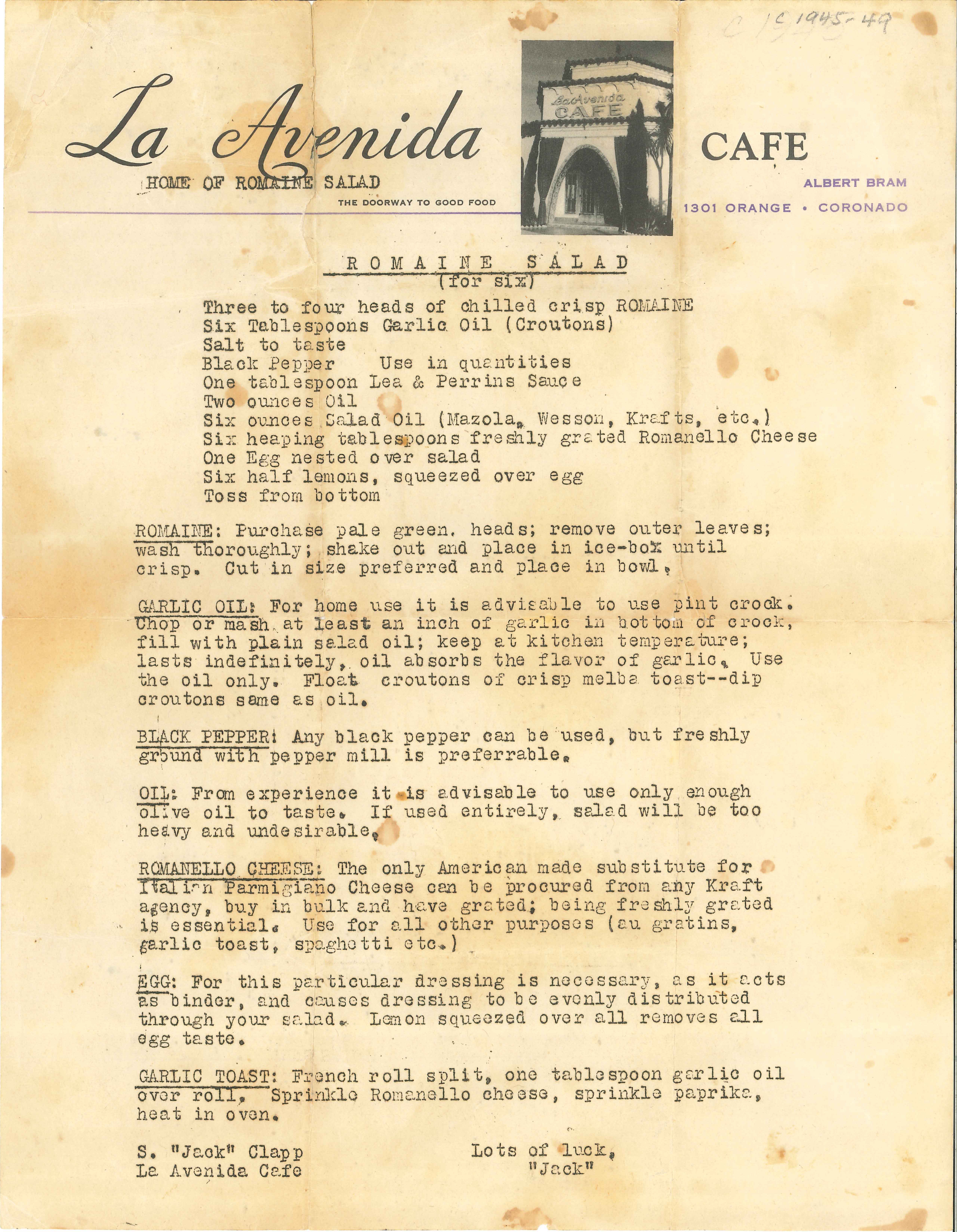- 619.435.7242
- 1100 Orange Avenue, Coronado CA 92118
La Avenida History
 The History of the La Avenida Complex and the Community’s Historical Desire to Save its Architecture and History
The History of the La Avenida Complex and the Community’s Historical Desire to Save its Architecture and History
by the Coronado Historical Association
The history of the iconic La Avenida Building on the corner of Orange and B Avenues begins with a Swiss immigrant, Albert Bram, who came to Coronado in 1928 to operate the “Island Lunch” café on Orange Avenue. In 1938, after enjoying success as a restaurant owner, Mr. Bram hired noted Coronado builder, Walter A. Vestal, to design and build the Spanish-Revival style La Avenida Restaurant at 1301 Orange Avenue. In addition to being a well-known builder, Walter Vestal was the Mayor of Coronado twice (from 1954 to 1956 and again from1964 to 1966). He also served on the Port Commission for ten years.
The building became distinguished not only for its popularity as a restaurant but also for its atmosphere, which included murals painted by Ramos Martinez, a painter, muralist, and educator who lived and worked in Mexico, Paris, and Los Angeles in the early 20th century, considered by many experts to be the “Father of Mexican Modernism”. At the time of its construction, and in the decades that have followed, the building has received multiple accolades for its unique Spanish-Revival architecture and has long served as an anchor to Orange Avenue and Coronado’s special identity.
As the decades passed, the heirs of Albert Bram, his grandchildren Dennis Robinson and Joy Pinto, ran the restaurant and adjacent La Avenida Motel. The property was sold to a developer interested in demolishing the restaurant and motel and replacing them with a new hotel on that block. Upon hearing of the plan to demolish the restaurant, a group of local preservationists, including the Coronado Historical Association, rallied to save the murals. There was also substantial community opposition to the demolition of the restaurant building (as shown both in local news and City Council minutes) with the opponents advocating in favor of preserving the La Avenida Complex over creating a new developer-backed hotel on Orange Avenue.
With a weakened economy, the developers defaulted on their loan and, when the property was foreclosed upon in 1992, the lenders, Gus and Barbara Theberge, became the owners. The new owners were sensitive to the artistic value of the Ramos Martinez murals and, with the assistance of the Coronado Historical Association and others, the murals were saved, restored, and are now on display in the Coronado Public Library.
In 1995, a Coronado Eagle headline confirmed the success of the community’s preservation efforts for the building by declaring “La Avenida Regains Former Landmark Status”. In the accompanying article, Jeanne Danis reported that the “gracious old landmark on the corner of B Avenue and Orange Avenue is going nowhere. It’s going to look almost the same, which is what most Coronadans wanted, according to co-owner-developer Barbara Therberge of La Avenida. ‘We had planned to give the corner a more modern look’…after hearing from a concerned public, ‘We took another look’ she said. After a ‘re-think’ and a re-design, she and her husband, Gus, and the Jackman Design Group came up with the same, charming Colonial Spanish, red-tiled look that the restaurant shopping corner has had since 1935.”
The article explains that the Theberge’s “involvement with La Avenida was not planned. During the late 1980s, they had held an interim loan on the Coronado property while a Chula Vista development firm and Japanese financiers formed plans to build a 150-unit hotel on the site.” Local opposition to the development centered on the expected increase in traffic in the center of town as well as necessary alterations to the medium strip in Orange Avenue. When the Japanese economy took a nose-dive, the Asian financiers withdrew their participation, and Mr. and Mrs. Theberge found themselves the owners of a 29-unit motel, an adjacent, but empty, restaurant building, and a former Martin's Home Furnishings, a much-beloved community business. After hearing from the community, they chose to restore the La Avenida restaurant to its former glory and donate the murals to the city.
In the early 2000s, the City of Coronado and community members developed the Orange Avenue Corridor Specific Plan to “provide a policy and regulatory bridge between the city of Coronado General Plan and individual, project-level development”. The Specific Plan was approved by the City Council in 2004 after multiple community workshops and citizen involvement. According to Chapter VI, the Commercial Zone Design Criteria, “the purpose of the design criteria is to protect the special identity of the commercial areas of Coronado”, in particular, to “Protect the architectural character”. The La Avenida Complex (which includes 1301 and 1309 Orange Avenue) is listed as a “Role Model Building” in the Specific Plan.
The building will no longer maintain its architectural style and will lose the uniqueness that makes it a “Role Model Building” in the Specific Plan if the arches, deep recesses, or corner tower (sometimes called the cupola or turret) are removed.
Not only is the La Avenida Complex a beloved landmark known for its Spanish-Revival arches, corner tower, and the original home of the Ramos Martinez murals, now immaculately preserved at the library, but it is also famous for Jack’s Salad. In the spirit of La Avenida’s history and importance to our community, we happily share the famous (and delicious!) recipe for Jack’s Salad. Enjoy the salad and toast the iconic La Avenida building tonight!
Jack's Salad Recipe
Jack Clapp worked for Caesar Cardini at The Caesar’s Palace in Tijuana Mexico. He brought this version of the Caesar Salad (Jack’s Salad) to La Avenida Café in Coronado.

Jack's Salad Recipe (as adapted by CHA Volunteer Carol Pastor)
Ingredients
- 1 garlic clove (or 1/4 - 1/2 tsp chopped garlic)
- 1/2 c olive oil
- 2 large heads romaine
- freshly ground pepper
- 2 eggs. cooked 1 minute (or raw)*
- juice of 1 large lemon
- 6-8 anchovy fillets, chopped or 1/2 inch anchovy paste
- 1/2 c grated Parmesan cheese
- 1 c grated jack cheese
- 2 c soft croutons
Directions
- In a small bowl, mix oil and garlic. Let it sit to “mingle” for several hours in the refrigerator.
- Tear romaine into bitesize pieces. (You can do this ahead. Place in the refrigerator wrapped in a damp towel.)
- To mix. place romaine in a large salad bowl.
- Toss lettuce with garlic/oil.
- In same small bowl, mix eggs and anchovy.
- Toss with lettuce.
- Squeeze on lemon juice.
- Add cheeses and toss again.
- Add croutons and toss again.
- To be really authentic, serve on chilled plates
To make croutons
- 4 slices sourdough bread
- butter
- more Parmesan cheese
- Toast one side of the bread under the broiler.
- Turn over and spread with butter.
- Sprinkle with Parmesan cheese.
- Return to broiler until cheese melts and bread is slightly toasted.
- Cut into 1/2 inch cubes.
Serves: 12
Source: Jack Clapp, La Avenida Café
*Consuming raw or undercooked meats, poultry, seafood, shellfish, or eggs may increase your risk of foodborne illness, especially if you have certain medical conditions.
Special thanks to Christian Esquevin, former Coronado Public Library Director, for research information about the history of the building.

Become a member
Join us and help preserve and share Coronado's unique and wonderful history with intriguing exhibits and innovative programs for all ages.
MEMBERSHIP BENEFITS INCLUDE:
- Two complimentary tickets to our Historic Walking Tour of Coronado
- Invites to members-only events
- ...and much more!